Discover the ultimate guide to choosing the perfect bathroom floor. Learn about different flooring materials, installation methods, maintenance tips, and cost considerations to make an informed decision for your bathroom renovation.

Deciding on the perfect floor for your bathroom involves more than just making a design choice. It’s a combination of aesthetics, functionality, and budget considerations.
Whether you’re renovating your existing bathroom or building a new one, the flooring you choose can greatly impact the overall look and feel of the space.
However, it’s not just about appearance. You also need to think about factors such as durability, ease of maintenance, and costs.
In this comprehensive guide, we will explore all these aspects in detail. We will discuss popular flooring materials, installation methods, maintenance tips, and even delve into cost considerations.
So, whether you’re a first-time homeowner or an experienced renovator, this guide aims to provide you with all the information you need to select the ideal bathroom floor.
Flooring Materials
In order to choose the ideal material for your bathroom floor, we will examine the five most common types of flooring materials, assessing their suitable applications, advantages, and disadvantages.
Tile
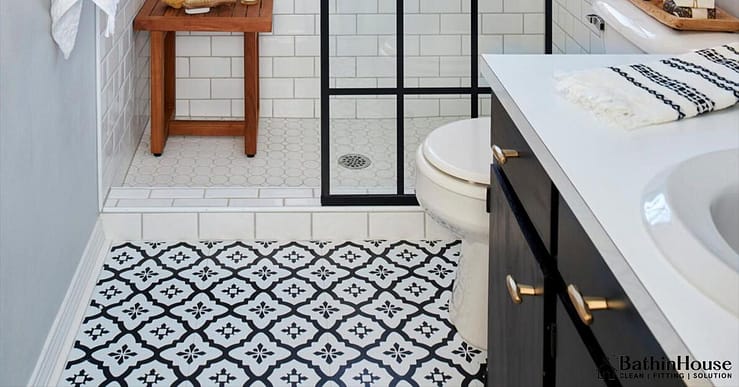
Tile is an excellent choice for those prioritizing durability and design variety but may require a higher upfront investment and professional installation.
Best Use-Case:
- High-traffic bathrooms
- Luxurious master bathrooms
Pros:
- Water-resistant
- Wide variety of designs and textures
- Durable and long-lasting
Cons:
- Cold underfoot
- Can be slippery when wet
- Potentially higher installation cost
Wood
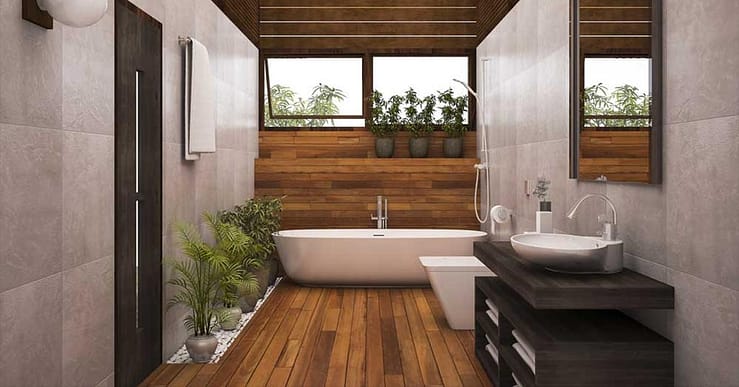
Wood offers a warm aesthetic but is best suited for bathrooms with lower moisture levels, like powder rooms.
Best Use-Case:
- Powder rooms
- Bathrooms where comfort and aesthetics are prioritized
Pros:
- Warm, natural appearance
- Comfortable underfoot
- Easy to install
Cons:
- Susceptible to water damage
- Requires regular maintenance
- Not ideal for high-moisture environments
Vinyl
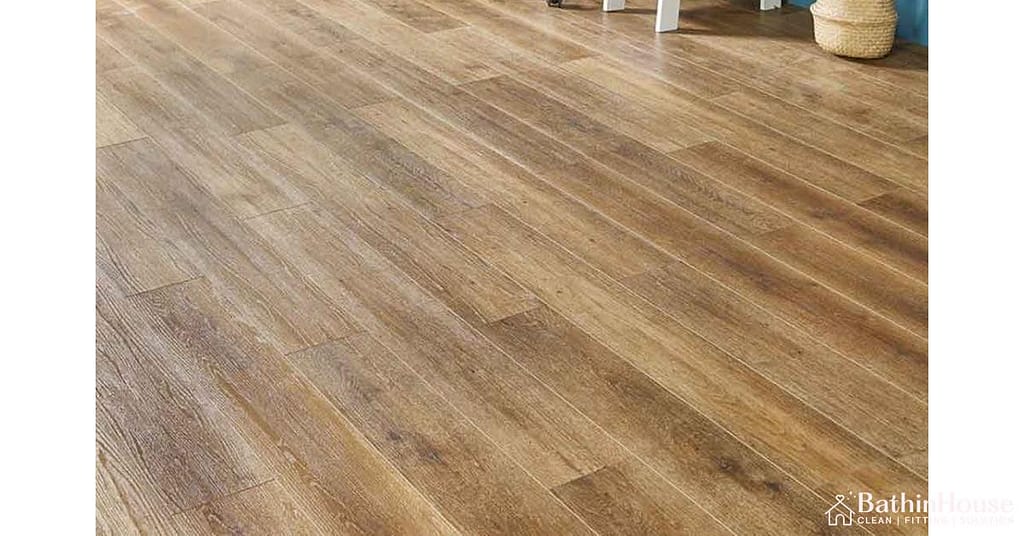
Vinyl is an excellent option for those on a budget or looking for DIY-friendly installation, but it may lack in durability and aesthetic appeal.
Best Use-Case:
- Children’s bathrooms
- Budget renovations
Pros:
- Water-resistant
- Cost-effective
- Easy DIY installation
Cons:
- Less durable compared to other materials
- Limited design options
- May look less luxurious
Laminate

Laminate offers a balance between aesthetics and ease of installation but is less suited for high-moisture environments.
Best Use-Case:
- Guest bathrooms
- Quick renovations
Pros:
- Mimics natural materials like wood and stone
- Easier to install than tile or wood
- Relatively inexpensive
Cons:
- Not fully water-resistant
- Can warp or swell in high-moisture environments
- Limited lifespan compared to other materials
Concrete

Concrete is ideal for those seeking an industrial look or extreme durability but may require professional installation and sealing.
Best Use-Case:
- Industrial-style bathrooms
- High-traffic commercial bathrooms
Pros:
- Extremely durable
- Customizable with dyes and textures
- Excellent for radiant floor heating
Cons:
- Cold and hard underfoot
- Porous if not properly sealed
- Professional installation required
This will enable you to make a well-informed decision for your bathroom renovation. For a deeper dive into different flooring options, you can also check out our extensive guide on Types of Bathroom Flooring.
How to Install a Bathroom Floor
Selecting the right method for installing your bathroom floor can significantly influence both the project’s success and overall cost.
The approach you choose largely depends on the flooring material, your skill level, and your budget.
Let’s break down the two primary installation methods—
- DIY
- Professional
DIY Installation

DIY is best suited for simpler materials like vinyl and laminate, which are forgiving to mistakes and don’t require specialized tools. It’s also ideal for those who have some level of handyman skills.
Best Use-Case:
- Vinyl and laminate floors
- Smaller bathrooms
- Budget-conscious projects
Key Considerations for DIY:
- Preparation: Make sure to clean and level the subfloor before installation.
- Tools: Depending on the material, you may need specific tools like tile cutters or rubber mallets.
- Time: Factor in not just the installation time but also preparation and finishing touches.
Pros:
- Cost-effective
- Greater control over project timeline
- Sense of personal accomplishment
Cons:
- Risk of incorrect installation
- May require specialized tools
- Time-consuming for novices
Professional Installation

Professional installation is advisable for complex materials like tile or wood, which require a high skill level for proper execution. It’s also ideal for larger projects where the time factor and quality of installation are critical.
Best Use-Case:
- Tile, wood, and concrete floors
- Larger, more complex bathroom layouts
- Projects where budget is less of a constraint
Key Considerations for Professional Installation:
- Contractor Selection: Ensure your contractor has the necessary certifications and positive reviews.
- Quote: Get multiple quotes to understand the market rate.
- Timeline: Discuss the project timeline in advance to avoid scheduling conflicts.
Pros:
- Expert quality assurance
- Quick and efficient execution
- Access to trade discounts on materials
Cons:
- Higher upfront costs
- Less control over project timeline
- Potential for scheduling conflicts
The decision between DIY and professional installation has a significant impact on the cost and success of your bathroom floor renovation. By carefully considering the advantages, disadvantages, and ideal scenarios for each method, you can choose the most suitable approach for your specific bathroom floor material and project needs.
Bathroom Floors Problems
Understanding common problems with bathroom floors is crucial before choosing and installing a new floor. These problems include water damage, cracked or loose tiles, grout issues, and slipperiness.
- Water Damage
- Cracked or Loose Tiles
- Grout Issues
- Slipperiness
Water Damage
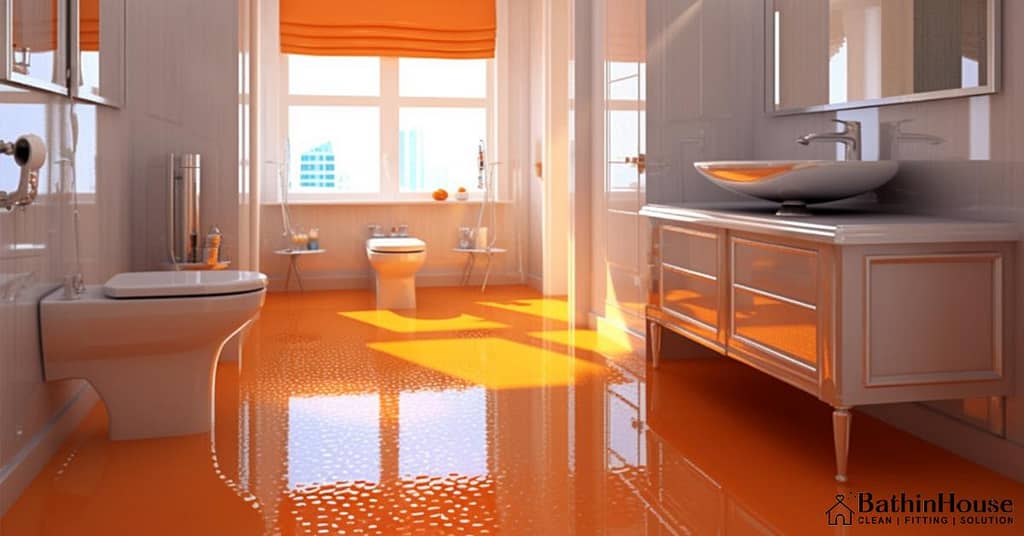
One of the most common issues with bathroom floors is water damage. Whether caused by leaks, humidity, or poor drainage, water damage can significantly impact the integrity of your flooring.
Signs of water damage on a bathroom floor include discoloration, warping, and softening of the material. You may also notice a musty odor, indicating the presence of mold and mildew, which often accompany water damage.
Certain flooring materials, such as hardwood or laminate, are particularly vulnerable to water damage.
Choosing water-resistant options like ceramic or porcelain tiles can help address this problem.
Cracked or Loose Tiles

Cracked or loose tiles not only affect the appearance of your bathroom floor but can also result in water seepage, leading to extensive damage.
This water seepage can cause harm to the subfloor and promote the growth of mold. Additionally, loose tiles pose a tripping hazard and may require more extensive repairs if not addressed promptly.
To prevent tile-related issues, it is advisable to opt for professional installation, especially for materials that require specialized skills.
Grout Issues

Grout discoloration and crumbling are common issues that can make your bathroom floor look unkempt.
To maintain the condition and extend the lifespan of tile floors, regular grout maintenance is critical.
This includes regular cleaning with specialized grout cleaners, applying a sealant to prevent moisture absorption, and, in extreme cases, re-grouting if necessary.
Slipperiness
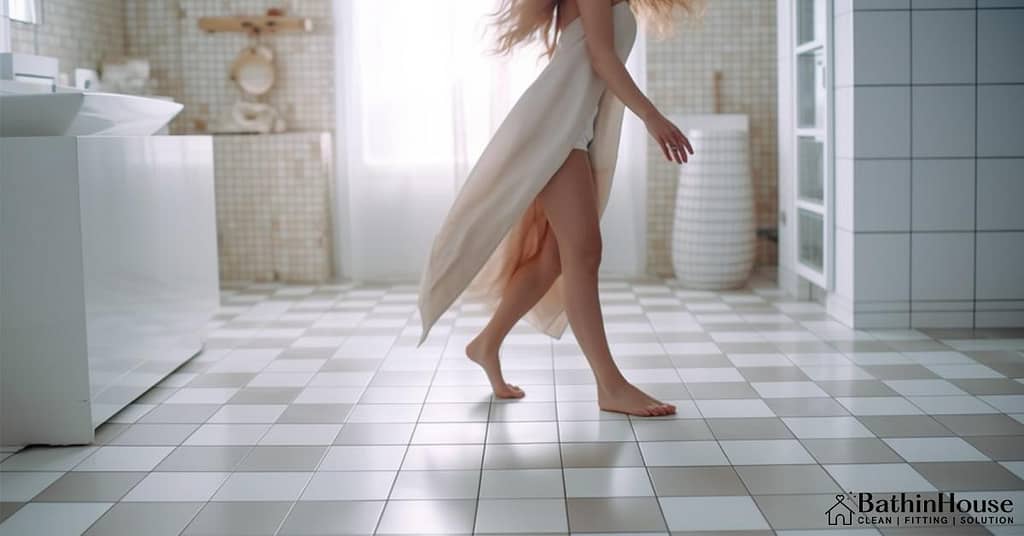
To improve bathroom floor safety, choose materials with textured surfaces like slate or pebbled tiles.
Additionally, consider using anti-slip mats and coatings. Textured tiles or rubber flooring offer better grip and are safer options for bathroom use. For an in-depth look at these issues, check out our article on common bathroom floor problems.
Tips for a Long-lasting Bathroom Floor
Regardless of the material you choose for your bathroom floor, its longevity is heavily dependent on regular and effective maintenance. A well-maintained floor not only looks better but also functions optimally over time, saving you from frequent and costly repairs.
Simple Cleaning Methods
- To maintain ceramic and porcelain tiles, use a mixture of warm water and mild detergent for regular cleaning.
- For hardwood floors, use specialized wood cleaners.
- Vinyl floors can be cleaned with a pH-balanced cleaner to prevent surface damage.
Always remember to thoroughly dry the floor after cleaning to prevent moisture-related issues.
Long-term Care
To ensure the long-term durability of your bathroom floor, it is important to prioritize regular maintenance.
This includes periodic deep cleaning, resealing surfaces as necessary, and promptly addressing any visible issues such as cracks or loose tiles.
For tile floors, it is recommended to reseal the grout annually to prevent moisture penetration.
Wood floors may require occasional refinishing to maintain their appearance, while vinyl floors can benefit from a polish every few years to retain their shine.
Cost Considerations
The cost of renovating or installation a bathroom floor is an important consideration when making decisions.
The total cost can vary significantly depending on factors such as the
- Type of material chosen
- Labor charges
- Additional expenses like tools and supplies
It’s important not to compromise on quality as choosing lower quality materials may result in higher maintenance costs over time.
Material Costs
The choice of material is a significant cost factor when considering a bathroom floor renovation. Porcelain tiles may be pricier than vinyl, but they provide enhanced durability. Meanwhile, natural stone options like marble or granite are typically the most expensive due to their exceptional aesthetics. To gain a comprehensive understanding, it is important to compare the cost per square foot of various materials.
Labor Costs
Labor costs can vary depending on the complexity of the installation and the rates of the professionals you hire. Materials that are easy to install, like vinyl, can often be done DIY, saving on labor costs. However, intricate designs or specialized materials like natural stone often require skilled labor, adding to the overall cost.
Additional Expenses
Cost of removing the old flooring
- Disposal fees
- Specialized tools or adhesives required for the new floor
Also, unforeseen issues like a damaged subfloor can escalate costs.
Conclusion
Choosing the right floor for your bathroom is a big decision that involves a lot of things to think about.
From the type of material like tile or wood to how easy it is to install and keep clean, every little detail matters.
Your choices will not only affect how your bathroom looks but also how much you’ll spend now and in the long run.
New trends and materials are always popping up, so keeping an eye on the latest styles can give you more options to consider.
Whether you want a classic look with tiles or something more modern, your decision will play a big role in how your bathtub, shower, toilet, and bathroom accessories function and how long they will last.

A person essentially help to make critically posts I might state. That is the very first time I frequented your web page and up to now? I surprised with the analysis you made to create this particular put up amazing. Wonderful activity!
Thank You.